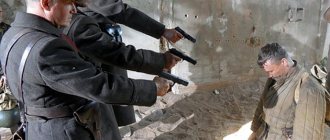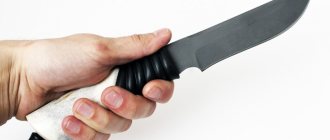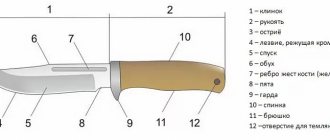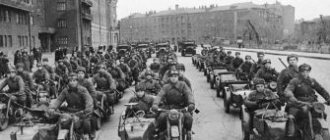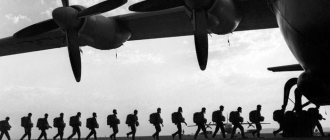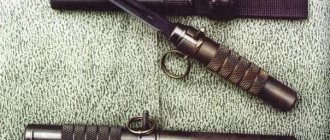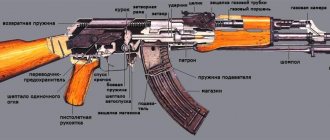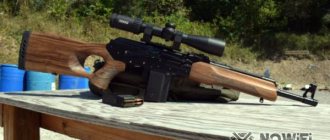The secret unit “Kholuai” of the Pacific Fleet, also known as 42 MCI Special Forces (military unit 59190), was created in 1955 in Maly Ulysses Bay near Vladivostok, and was later relocated to Russky Island, where to this day reconnaissance saboteurs undergo combat training. There are many legends about these guys, their physical fitness is admired, they are called the best of the best, the cream of the special forces. Each of them could become the protagonist of an action movie. Today RIA PrimaMedia is publishing material by military historian and journalist Alexei Sukonkin about the legendary part “Kholuai”. In 1993-94, he served in a special forces unit of the ground forces, but from time to time they were also part of the naval special forces.
Preface
“Surprisingly for the enemy, we landed at a Japanese airfield and entered into negotiations. After that, the Japanese took ten of us to the headquarters of the colonel, the commander of the aviation unit, who wanted to make hostages out of us. I joined the conversation when I felt that the representative of the Soviet command, Captain 3rd Rank Kulebyakin, who was with us, was, as they say, “backed against the wall.” Looking the Japanese in the eyes, I said that we had fought the entire war in the west and had enough experience to assess the situation, that we would not be hostages, but rather, we would die, but we would die along with everyone who was at headquarters. The difference is, I added, that you will die like rats, and we will try to escape from here. Hero of the Soviet Union Mitya Sokolov immediately stood behind the Japanese colonel. Hero of the Soviet Union Andrei Pshenichnykh locked the door with a key, put the key in his pocket and sat down on a chair, and Volodya Olyashev (after the war - Honored Master of Sports) lifted Andrei along with the chair and placed him directly in front of the Japanese commander. Ivan Guzenkov went to the window and reported that we were not high, and Hero of the Soviet Union Semyon Agafonov, standing at the door, began tossing an anti-tank grenade in his hand. The Japanese, however, did not know that there was no fuse in it. The colonel, forgetting about the handkerchief, began to wipe the sweat from his forehead with his hand and after some time signed the act of surrender of the entire garrison.”
This is how naval reconnaissance Viktor Leonov, twice Hero of the Soviet Union, described just one military operation in which a handful of daring and brave naval reconnaissance officers of the Pacific Fleet literally forced a large Japanese garrison to lay down their arms without a fight. Three and a half thousand Japanese samurai shamefully surrendered.
Viktor Leonov and comrades after the battle for Seisin. Photo: from the Red Star archive
This was the apotheosis of the combat power of the 140th naval reconnaissance detachment, the harbinger of modern naval special forces, which today everyone knows under the incomprehensible and mysterious name “Holuai”.
4. Strategic Missile Forces
The Strategic Missile Forces are an elite special forces unit in service with the state. They belong to the troops that are in constant and full combat readiness. The Strategic Missile Forces are armed with intercontinental ballistic missiles with warheads. The formation of special forces occurred in the middle of the last century. Today, the missile forces comprise 3 armies, which include 12 missile divisions. The Strategic Missile Forces are armed with more than three hundred complexes of various types.
INTERESTING TOP 10 Best works of postmodern literature
Origins
And it all started during the Great Patriotic War. At that time, the 181st reconnaissance detachment successfully operated in the Northern Fleet, carrying out various special operations behind enemy lines. The crowning achievement of this detachment’s activity was the capture of two coastal batteries at Cape Krestovoy (which blocked the entrance to the bay and could easily destroy an amphibious convoy) in preparation for landing in the port of Liinakhamari (Murmansk region - editor’s note). This, in turn, ensured the success of the Petsamo-Kirkenes landing operation, which became the key to success in the liberation of the entire Soviet Arctic. It is difficult to even imagine that a detachment of several dozen people, having captured only a few guns of German coastal batteries, actually ensured victory in the entire strategic operation, but, nevertheless, this is so - for this purpose the reconnaissance detachment was created in order to sting the enemy with small forces in the most vulnerable place...
The commander of the 181st reconnaissance detachment, Senior Lieutenant Viktor Leonov, and two more of his subordinates (Semyon Agafonov and Andrei Pshenichnykh) became Heroes of the Soviet Union for this short but important battle.
Twice Hero of the USSR Viktor Leonov. Photo: wikipedia.org
In April 1945, part of the personnel of the 181st detachment, led by the commander, was transferred to the Pacific Fleet to form the 140th reconnaissance detachment of the Pacific Fleet, which was supposed to be used in the upcoming war with Japan. By May, the detachment was formed on Russky Island in the amount of 139 people and began combat training. In August 1945, the 140th Reconnaissance Squadron took part in the capture of the ports of Yuki and Racine, as well as the naval bases of Seishin and Genzan. As a result of these operations, chief petty officer Makar Babikov and midshipman Alexander Nikandrov of the 140th reconnaissance detachment of the Pacific Fleet became Heroes of the Soviet Union, and their commander Viktor Leonov received the second Hero star.
However, at the end of the war, all such reconnaissance formations in the USSR Navy were disbanded due to imaginary uselessness.
But soon history turned around...
From the history of the creation of special-purpose units: In 1950, in the Armed Forces of the Soviet Union, separate special-purpose companies were formed in each army and military district. In the Primorsky Territory, in particular, three such companies were formed: the 91st (military unit No. 51423) as part of the 5th Combined Arms Army with a deployment in Ussuriysk, the 92nd (military unit No. 51447) as part of the 25th combined arms army stationed at the Boets Kuznetsov station and the 88th (military unit No. 51422) as part of the 37th Guards Airborne Corps stationed in Chernigovka. The special forces companies were tasked with searching for and destroying the most important military and civilian targets deep behind enemy lines, including enemy nuclear attack weapons. The personnel of these companies were trained in military reconnaissance, mine explosives, and made parachute jumps. For service in such units, people were selected who, for health reasons, were fit to serve in the airborne forces.
The experience of the Great Patriotic War showed the indispensability of such units for decisive actions on enemy communications, and in connection with the outbreak of the Cold War by the Americans, the need for such units became very clear. The new units showed their high efficiency already at the first exercises, and the Navy became interested in units of this kind.
The head of Navy intelligence, Rear Admiral Leonid Konstantinovich Bekrenev, wrote in his address to the Minister of the Navy:
“...taking into account the role of reconnaissance and sabotage units in the general reconnaissance system of fleets, I consider it necessary to carry out the following measures: ... create... reconnaissance and sabotage units of military intelligence, giving them the name of separate naval reconnaissance divisions...”
At the same time, captain of the first rank Boris Maksimovich Margolin theoretically justified this decision, arguing that “... the difficulties and duration of training for reconnaissance light divers necessitate their advance preparation and systematic training, for which special units should be created...”.
Descent underwater. Photo: from the archive of Igor Dulnev
And so, by the Directive of the Main Naval Staff of June 24, 1953, similar special intelligence formations are formed in all fleets. In total, five “special purpose reconnaissance points” were formed - in all fleets and the Caspian flotilla.
The Pacific Fleet is creating its own reconnaissance point on the basis of the directive of the General Staff of the Navy No. OMU/1/53060ss of March 18, 1955.
However, “Unit Day” is considered June 5, 1955 - the day when the unit completed its formation and became part of the fleet as a combat unit.
Special Forces National Guard Troops
The special forces of the National Guard troops open the list of Russia's elite troops. The main task of the special forces is anti-terrorism measures. The detachments are engaged in the release of hostages, liquidation of unrest, and also liquidation of illegal armed groups. In addition, the competence of the National Guard troops includes the neutralization and detention of criminals who pose a particular danger to society. The special forces of this detachment celebrate their official day on March 27.
Kholuai Bay
The word “Kholuai” itself (as well as its variations “Khaluai” and “Khalulai”), according to one version, means “lost place”, and although disputes on this subject are still ongoing and sinologists do not confirm such a translation, the version is considered quite plausible - especially among those who served in this bay.
In the thirties, on Russky Island (at that time, by the way, its second name, Kazakevich Island, which disappeared from geographical maps only in the forties of the twentieth century, was widely practiced) construction of anti-landing defense facilities for Vladivostok was underway. Defense facilities included long-term coastal firing points - bunkers. Some especially fortified bunkers even had their own names, for example, “Stream”, “Rock”, “Wave”, “Bonfire” and others. All this defensive splendor was served by separate machine-gun battalions, each of which occupied its own defense sector. In particular, the 69th separate machine gun battalion of the Vladivostok coastal defense sector of the Pacific Fleet, located in the area of Cape Krasny in Kholuai Bay (New Dzhigit), served firing points located on Russky Island. For this battalion in 1935, a two-story barracks and headquarters, a canteen, a boiler room, warehouses and a stadium were built. The battalion was stationed here until the forties, after which it was disbanded. The barracks were not used for a long time and began to collapse.
First Deputy Chief of the GRU, Colonel General I. Ya. Sidorov, accepts the report of the commander of the special forces group. Photo: from the archive of V. M. Fedorov
And so, in March 1955, a new military unit with very specific tasks moved here, the secrecy of its existence was brought to the highest limit.
In open use among the “initiates,” the unit was called the “Irtek Recreation Center” of the Main Naval Base “Vladivostok.” The unit also received the code name military unit No. 59190 and the open name “42nd Special Purpose Marine Reconnaissance Point.” The people had a “folk” name for the part - “Kholuai” - after the name of the bay.
So what was this part? Why are so many different legends hovering around her, both then and today, sometimes bordering on fantasy?
FSSP of Russia
The SSP of Russia undoubtedly belongs to the elite troops of the Russian Federation. It has rapid response teams that must undergo special training. The FSSP is armed with automatic weapons and ensures the security of courts, and also personally protects the leadership of the Federal Bailiff Service.
Exercises and service
In 1956, naval reconnaissance officers began to master parachute jumps. Typically, training sessions took place at naval aviation airfields, based on subordination. During the first training camp, all personnel performed two jumps from a height of 900 meters from Li-2 and An-2 aircraft, and also learned to land “assault-style” from Mi-4 helicopters - both on land and on water.
Another year later, naval reconnaissance officers had already mastered landing on the shore through the torpedo tubes of submarines lying on the ground, as well as returning to them after completing a mission at the coastal facilities of a mock enemy. Based on the results of combat training in 1958, the 42nd Naval Reconnaissance Point became the best special unit of the Pacific Fleet and was awarded the challenge pennant of the Commander of the Pacific Fleet.
In many exercises, intelligence officers developed the necessary skills, acquired special knowledge and expressed their wishes regarding the composition of the equipment. In particular, back in the late fifties, naval intelligence officers formulated requirements for weapons - they should be light and silent (as a result, samples of special weapons appeared - small-sized silent pistols MSP, silent grenade launchers "Silence", underwater pistols SPP-1 and underwater assault rifles APS, as well as many other special weapons). The scouts also wanted to have waterproof outerwear and shoes, and their eyes needed to be protected from mechanical damage with special safety glasses (for example, today the equipment set includes four types of safety glasses).
In 1960, the unit's staff was increased to 146 people.
By this time, we had already decided on our specialization, which was divided into three areas:
- part of the personnel was represented by reconnaissance divers , who were supposed to conduct reconnaissance of enemy naval bases from the sea, as well as mine ships and port facilities;
- some of the sailors were engaged in conducting military reconnaissance - in other words, having landed from the sea, they acted on the shore as ordinary land reconnaissance officers;
- the third direction was represented by radio and radio-technical intelligence specialists - these people were engaged in instrumental reconnaissance, which made it possible to quickly detect the most important objects behind enemy lines, such as field radio stations, radar stations, technical observation posts - in general, everything that emitted in broadcast any signals and had to be destroyed first.
Marine special forces began to receive special underwater carriers - in other words, small underwater vehicles that could deliver saboteurs over long distances. Such a carrier was the two-seat "Triton", later - also the two-seat "Triton-1M", and even later the six-seat "Triton-2" appeared. These devices allowed saboteurs to quietly penetrate directly into enemy bases, mine ships and piers, and perform other reconnaissance tasks.
These were very secret devices, and the more “horrible” was the story when a naval special forces officer, secretly escorting containers with these devices (in civilian clothes under the guise of a regular cargo forwarder), suddenly heard with a trembling knees how a slinger was in charge of reloading a container from a railway platform on the truck, loudly shouted to the crane operator: “ Petrovich, lift it carefully, there are NEWTs here ”... and only when the officer pulled himself together, calmed down his trembling and calmed down a little, he realized that no leak of top-secret information had occurred, and the unlucky slinger only had meaning THREE TONS of container weight (that’s how much the Triton-1M weighed), and not the most secret Tritons that were inside...
For reference:
"Triton" is the first carrier for open-type divers. Immersion depth is up to 12 meters. Speed - 4 knots (7.5 km/h). Range: 30 miles (55 km).
"Triton-1M" is the first closed-type carrier for divers. Weight - 3 tons. Immersion depth is 32 meters. Speed - 4 knots. Range - 60 miles (110 km).
Triton-2 is the first closed-type group carrier for divers. Weight - 15 tons. Immersion depth is 40 meters. Speed - 5 knots. Range: 60 miles.
Currently, these types of equipment are already outdated and withdrawn from combat service. All three samples are installed as monuments on the territory of the unit, and the decommissioned Triton-2 apparatus is also presented at the street exhibition of the Museum of Military Glory of the Pacific Fleet in Vladivostok.
Triton on a pedestal in part. Photo: Alexey Sukonkin
Triton on a pedestal in part. Photo: Alexey Sukonkin
Triton on a pedestal in part. Photo: Alexey Sukonkin
1
/ 3
Currently, such underwater carriers are not used for a number of reasons, the main one of which is the impossibility of using them covertly. Today, naval special forces are armed with more modern underwater carriers “Sirena” and “Proteus” of various modifications. Both of these carriers allow for the secret landing of a reconnaissance group through a submarine's torpedo tube. “Siren” “carries” two saboteurs, and “Proteus” is an individual carrier.
Aerospace Forces of the Russian Federation
The elite undoubtedly includes the aerospace forces of the Russian Federation, whose main tasks are to protect the state in the aerospace field, detect and completely defeat the enemy, as well as repulse combat operations with ballistic missiles. In addition, the competence of the aerospace forces includes identifying possible combat missile strikes and being in a state of full combat readiness. The Russian Aerospace Forces are part of the Aerospace Forces. The main tasks of the newest special forces are monitoring objects in space, as well as timely detection and combating space threats.
Insolence and sport
Some of the legends about “Kholuai” are associated with the steady desire of the military personnel of this unit to improve their reconnaissance and sabotage skills at the expense of their own comrades. At all times, the “Kholuai” caused many problems to daily duty personnel serving on ships and in coastal units of the Pacific Fleet. There were frequent cases of “training” abductions of orderlies, duty documentation, and theft of vehicles from careless military drivers. It cannot be said that the command of the unit specifically assigned such tasks to the scouts... but for successful actions of this kind, the reconnaissance sailors could even receive short-term leave.
There are many fairy tales about how special forces soldiers “are thrown out in the middle of Siberia with one knife, and he must survive and return to his unit.”
No, of course, no one is thrown out anywhere with just a knife, but during special tactical exercises, reconnaissance groups can be sent to other regions of the country, where they are given various training reconnaissance and sabotage tasks, after which they need to return to their unit - preferably undetected . At this time, the police, internal troops and state security agencies are intensively looking for them, and citizens are told that they are looking for conditional terrorists.
In the unit itself, sports have been cultivated at all times - and therefore one should not be surprised that even today, at almost all naval competitions in strength sports, martial arts, swimming and shooting, prize-winning places are usually taken by representatives of “Kholuy”. It should be noted that preference in sports is given not to strength, but to endurance - it is this physical skill that allows a naval reconnaissance to feel confident both on foot or ski trips, and in long-distance swimming.
Unpretentiousness and the ability to live without excesses even gave rise to a peculiar saying on “Kholuay”:
“Some things are not necessary, but some things you can limit yourself to.”
It contains a deep meaning, which in many ways reflects the essence of the naval reconnaissance officer of the Russian Navy - who, being content with little, is capable of accomplishing a lot.
Healthy special forces chauvinism also gave rise to the special audacity of the intelligence officers, which became a source of pride for the naval special forces fighters. This quality was especially evident during exercises, which were and are being carried out almost constantly.
One of the admirals of the Pacific Fleet once said:
“The naval special forces guys were brought up in the spirit of love for the Motherland, hatred of enemies and the awareness that they are the elite of the fleet. Not for the feeling of their own superiority over others, but in the sense that huge public funds are spent on them, and it is their duty, if something happens, to justify these costs...”
I remember in my early childhood, in the mid-eighties, on the embankment near the S-56 I saw a lonely wandering sailor with a parachutist badge shining on his chest. At this time, a ferry was loading at the pier, heading to Russky Island (there were no bridges at that time). The sailor was stopped by a patrol, and he presented his documents, gesticulating desperately, pointing at the ferry, which was already raising the ramp. But the patrol, apparently, decided to detain the sailor for some offense.
And then I saw a whole performance: the sailor sharply pulled the cap of the senior patrolman right over his eyes, snatched his documents from his hands, slapped one of the patrolmen in the face, and rushed headlong to the departing ferry!
And the ferry, I must say, had already moved one and a half to two meters away from the pier, and the sailor-paratrooper overcame this distance in a graceful jump, grabbed the ferry's railing, and there he was already pulled on board by the passengers. For some reason, I have no doubts in which unit that sailor served...
Return of a Legend
In 1965, twenty years after the end of World War II, twice Hero of the Soviet Union, Captain First Rank Viktor Leonov, came to the unit. Several photographs have been preserved in which the “legend of naval special forces” is captured with military personnel of the unit, both officers and sailors. Subsequently, Viktor Leonov would visit the 42nd reconnaissance point several more times, which he himself considered a worthy brainchild of his 140th reconnaissance detachment...
Leonov arrived in a naval special forces unit, 1965. Photo: from the archive of V. M. Fedorov
In 2015, Viktor Leonov returned to the unit forever. On the day of the 60th anniversary of the formation of the reconnaissance point on the territory of the military unit, a monument to the real legend of naval special forces, Twice Hero of the Soviet Union Viktor Nikolaevich Leonov, was unveiled in a solemn ceremony.
Monument to Leonov. Photo: Sergey Lanin, RIA PrimaMedia
"A reason to be proud"
Every day Constantinople talks about an event in the history of our great country. The chronicles of past years certainly intersect with the present. Looking back, we understand who we should follow, what mistakes we should avoid, and what we can do for a happy future for our children.
Photos courtesy of globallookpress.com.
Log in or register to leave comments.
Tags:
black death a reason for pride Marine Corps Russia Navy Marine Corps Day
Combat use
In 1982, the moment came when the Motherland demanded the professional skills of naval special forces. From February 24 to April 27, a regular special forces group performed combat service tasks for the first time, being on one of the Pacific Fleet ships.
In 1988 - 1989, a reconnaissance group equipped with Siren underwater carriers and all the necessary combat equipment was in combat service for 130 days. A small reconnaissance ship from the 38th brigade of reconnaissance ships of the Pacific Fleet delivered the Kholuaevites to the place of their combat mission. It is too early to say what these tasks were, because they are still hidden under a veil of secrecy. One thing is clear - some enemy has become very ill these days...
In 1995, a group of military personnel from the 42nd Special Purpose Naval Reconnaissance Point took part in a combat operation to establish a constitutional regime in the Chechen Republic.
The group was attached to the 165th Marine Regiment of the Pacific Fleet operating there and, according to the reviews of the senior commander of the Pacific Fleet Marine Corps group in Chechnya, Colonel Sergei Konstantinovich Kondratenko, acted brilliantly. The scouts remained calm and courageous in any critical situation. Five “Kholuaevites” laid down their lives in this war. Ensign Andrei Dneprovsky was posthumously awarded the title of Hero of Russia.
From the award list:
“...organized the training of the battalion’s freelance reconnaissance group and skillfully acted as part of it. On February 19, 1995, in a battle in the city of Grozny, he personally saved the lives of two sailors and carried out the body of the deceased sailor A.I. Pleshakov. On the night of March 20-21, 1995, while carrying out a combat mission to capture the Goitein Court heights, A.V. Dneprovsky’s reconnaissance group secretly approached the height, identified and neutralized the militants’ military outpost (one was killed, two were captured). Subsequently, during a short-lived battle, he personally destroyed two militants, ensuring the company’s unhindered approach to the heights and the completion of the combat mission without losses...”
On the same day, he died heroically while performing a subsequent task... In 1996, a monument to the military personnel of the unit who died in the line of military duty was erected on the territory of the unit.
Aboard
By patrolling the Gulf of Aden, Russian marines help fight pirates. One of the most famous examples happened in 2010, when the Russian tanker Moscow University was hijacked on May 5. Our crew was blocked 930 km from Somalia. The sailors barricaded themselves in the engine room, and the captain of the tanker managed to transmit a distress signal. For 20 hours, pirates robbed the tanker, trying to get to the crew. And then the Marines approached the ship. After a short firefight, the fighters took control of the ship. One pirate was killed, the rest were captured and later released with food and water supplies, but without means of navigation. All Russian military personnel who took part in the liberation of the ship were presented with state awards.

